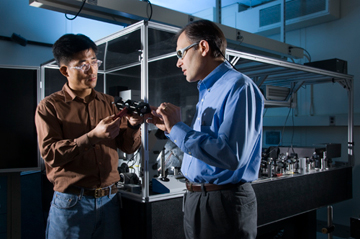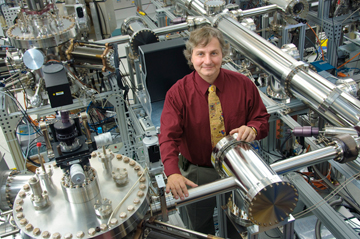Advancing Innovation and Industrial Competitiveness
NIST test methods, measurement tools, and scientific data are embedded in technologies, products, and services that are produced or used in every sector of the economy. For most U.S. cell phone systems, all the cell towers in the network must be synchronized to within one millionth of a second per day—and NIST routinely provides time measurements 10,000 times more accurate than that. NIST standards help ensure the safety and quality of more than 30 million mammograms each year. Automated tellers, flat panel displays, search engines, even advanced concrete. Nearly all the high-tech products and services we rely on every day depend on NIST research, standards, and programs.
Founded in 1901 and now part of the U.S. Department of Commerce, NIST is one of the nation's oldest physical science laboratories. Congress established the agency to remove a major handicap to U.S. industrial competitiveness at the time—a second-rate measurement infrastructure that lagged behind the capabilities of England, Germany, and other economic rivals. Today, NIST measurements support the smallest of technologies—nanoscale devices so tiny that tens of thousands can fit on the end of a single human hair—to the largest and most complex of human-made creations, from earthquake-resistant skyscrapers to wide-body jetliners to global communication networks. NIST's Innovation Toolkit
NIST has a century-long tradition of partnering with business and universities, and its main programs support the nation’s vast innovation ecosystem:
Basics—Who, What, Where, HowNIST has campuses in Gaithersburg, Md., and Boulder, Colo. In addition, NIST collaborates with several federal and state institutions to run the Hollings Marine Laboratory in Charleston, S.C., and jointly operates two fundamental physics institutes, JILA with the University of Colorado Boulder and the Joint Quantum Institute with the University of Maryland, College Park. In addition, the Institute for Bioscience and Biotechnology Research, headquartered in Rockville, Md., is a joint research center established by NIST, the University of Maryland College Park, and the University of Maryland Baltimore to foster multidisciplinary biotechnology and biomedical research. Also, in 2012, NIST, in partnership with the State of Maryland, established the National Cybersecurity Center of Excellence, a public-private collaboration for accelerating the widespread adoption of integrated cybersecurity tools and technologies. NIST employs about 2,900 scientists, engineers, technicians, and support personnel. Each year, NIST hosts about 2,600 associates and facility users from academia, industry, and government agencies. We also partner with 1,300 manufacturing specialists and staff at over 350 MEP service locations around the country. New research results and NIST technical expertise are communicated and put into practice by a variety of means. In a typical year, the agency's scientists and engineers publish about 2,000 professional journal articles and technical reports. NIST also offers more than 1,300 Standard Reference Materials (SRMs)—painstakingly characterized and consistently produced materials that are used to check the accuracy of instruments and test procedures. In 2011, it distributed more than 32,000 SRMs to customers in U.S. industry and around the world. NIST staff perform about 18,000 calibration tests annually, as well as accredit some 800 private and public testing and calibration laboratories. NIST also maintains the nation's standards for time and frequency measurement, which are integral to the performance of advanced communication and broadcast systems, power grids, and high-speed commerce. Every day, our Internet Time Service, used to automate synchronization of computer clocks, receives more than 11 billion requests for official NIST time. In addition, NIST's laboratories critically evaluate and compile about 100 collections of science and engineering reference data—the "currency" for exchanging research information. Customer downloads of data, not including time downloads, total more than 19 million annually. Helping America CompeteAs technological change accelerates and as other nations increase investments in R&D and incentives to grow and attract high-technology industries, the United States faces unprecedented challenges. Leadership in critical areas of advanced technology—the wellspring of future economic growth—is at stake. With the reauthorization of the landmark America COMPETES Act in 2010, the federal government has boosted its commitment to science, technology, and education, as a way to spur innovation, create jobs, and make U.S. businesses more competitive abroad. In particular, the new act authorizes funding for NIST that would double its core laboratory program budget over time. The law also strengthens NIST's role in technological innovation and gives it new tools to support U.S. manufacturing. Standards MatterAmerica COMPETES also directs NIST to expand its work with the private sector to develop needed standards for a range of vital industries and technology areas, such as emergency communications and tracking, green manufacturing, and high-performance buildings. The National Technology Transfer and Advancement Act of 1997 gave NIST the job of coordinating government's development and use of technical standards and aligning these activities with the private sector. The need for coordination within and across sectors continues to grow as standards underpin the performance of today's most advanced and complex technologies and their ability to connect and work together. Examples are the emerging smart electric power grid, electronic health records, cloud computing, and cybersecurity. In all four of these strategically important and fast-moving areas, NIST has been named by Congress or directed by the Administration to work in partnership with the private sector to develop needed standards that support interoperability and industrial innovation. Development and wide-scale adoption of quality, consensus standards also serve to expand markets and increase demand for innovative products. Addressing Critical National Needs
Participation in interagency research efforts—National Nanotechnology Initiative, National Earthquake Hazards Reduction Program, National Strategy for Trusted Identities in Cyberspace, and National Initiative for Cybersecurity Education, among others, is another way NIST advances the nation's technology agenda. In addition, NIST has identified priority areas that tightly align its measurement research, services, and standards-related activities to help solve major national challenges in the areas of manufacturing, information technology and cybersecurity, energy, healthcare, environment and consumer safety, and physical infrastructure. For more information, visit the NIST website at www.nist.gov or contact NIST Public Inquiries at (301) 975-NIST (6478), email: inquiries@nist.gov. |



